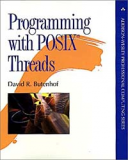Книга: Programming with POSIX® Threads
5.5.5.1 Priority ceiling mutexes
5.5.5.1 Priority ceiling mutexes
The simplest of the two types of "priority aware" mutexes is the priority ceiling (or "priority protection") protocol (Figure 5.3). When you create a mutex using a priority ceiling, you specify the highest priority at which a thread will ever be running when it locks the mutex. Any thread locking that mutex will have its

FIGURE 5.3 Priority ceiling mutex operation
priority automatically raised to that value, which will allow it to finish with the mutex before it can be preempted by any other thread that might try to lock the mutex. You can also examine or modify the priority ceiling of a mutex that was created with the priority ceiling (protect) protocol.
A priority ceiling mutex is not useful within a library that can be called by threads you don't control. If any thread that is running at a priority above the ceiling locks the priority ceiling mutex, the protocol is broken. This doesn't necessarily guarantee a priority inversion, but it removes all protection against priority inversion. Since the priority ceiling protocol adds overhead to each mutex operation compared to a normal "unprotected" mutex, you may have wasted processor time accomplishing nothing.
Priority ceiling is perfect for an embedded realtime application where the developers control all synchronization within the system. The priority ceiling can be safely determined when the code is designed, and you can avoid priority inversion with a relatively small cost in performance compared to more general solutions. Of course it is always most efficient to avoid priority inversion, either by avoiding priority scheduling or by using any given mutex only within threads of equal priority. Equally, of course, these alternatives rarely prove practical when you need them most.
You can use priority ceiling within almost any main program, even when you don't control the code in libraries you use. That's because while it is common for threads that call into library functions to lock library mutexes, it is not common for threads created by a library to call into application code and lock application mutexes. If you use a library that has "callbacks" into your code, you must either ensure that those callbacks (and any functions they call) don't use the priority ceiling mutexes or that no thread in which the callback might be invoked will run at a priority above the ceiling priority of the mutex.
- 16.4 Priority Inversion
- 16.4.1 Priority Inheritance Protocol
- 16.4.2 Ceiling Priority Protocol
- 16.4.3 Priority Ceiling Protocol
- ceiling()
- 5.5.5 Priority-aware mutexes
- 5.5.5.2 Priority inheritance mutexes
- 8.1.4 Beware of priority inversion
- 9.3.4 Mutexes
- SERVER PRIORITY CLASS
- Using Priority Scheduling and Control
- 3.2.3 Using mutexes for atomicity




